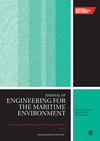粗糙变宽盆地中共振波演化的浅水方程模拟
IF 1.5
4区 工程技术
Q3 ENGINEERING, MARINE
Proceedings of the Institution of Mechanical Engineers, Part M: Journal of Engineering for the Maritime Environment
Pub Date : 2023-09-30
DOI:10.1177/14750902231198279
引用次数: 0
摘要
众所周知,波浪共振对周围的沿海地区具有极大的破坏性,特别是如果波浪具有类似海啸的特征,因为它可以放大波浪传播到海岸线的高度和能量。在底部安装粗糙材料是保护海岸免受共振的解决方案之一。在本研究中,我们使用变宽浅水模型研究了三角形或矩形半封闭盆地的共振波演化及其频率。假定盆地的底部地形粗糙,宽度不均匀。在交错网格上分别采用分离变量法和有限体积法对谐振频率进行了解析和数值计算。计算方法也被用于评估共振波的演化和性质。通过与解析解的比较,验证了数值方案的正确性,两者具有较好的一致性。进一步发现,摩擦系数越大,两种盆地的共振频率越高,但最大共振波幅值越低。两种变宽盆地的共振频率均大于前人研究的定宽盆地。然而,盆地最大宽度的变化对其共振频率的影响不显著。此外,还对盆地长度和最大水深进行了敏感性分析,最大水深与两个盆地的最大波幅和共振频率成正比。相反,共振频率随盆地长度的增加而减小,最大波幅也随盆地长度的增加而波动。本文章由计算机程序翻译,如有差异,请以英文原文为准。
Shallow Water Equations on modeling resonant waves evolution in a rough varying-width basin
Wave resonance is known to be extremely damaging to the coastal areas surrounding it, particularly if the wave has tsunami-like features, as it can amplify the height and energy of the wave propagating to the shorelines. The installation of a rough material on the bottom is one of the solutions to protect the coast from resonance. In this study, we examine the resonant wave evolution and its frequency in a triangular or rectangular semi-closed basin using a varying-width Shallow Water Model. The basins are assumed to feature a rough bottom topography as well as an uneven width. The resonant frequencies are obtained analytically and numerically using separation of variables and the finite volume method on a staggered grid, respectively. The computational approach is also used to assess the evolution and properties of resonant waves. The numerical scheme is validated by comparing simulation results to analytical solutions, which show relatively good agreement. Further, it is discovered that a greater friction coefficient induces a higher resonant frequency in both types of basins but results in a lower maximum resonant wave amplitude. It is also found that the resonant frequencies of both types of varying-width basins are greater than those of the prior study’s constant-width basins. However, the effect of the variations in the maximum width of the basin on its resonant frequency is found to be insignificant. Moreover, sensitivity analyses of the basin’s length and maximum basin depth are presented, with the maximum water depth being directly proportional to the maximum wave amplitudes and resonant frequencies of both basins. In contrast, the resonant frequency decreases and the maximum wave amplitude fluctuates as the length of the basin grows.
求助全文
通过发布文献求助,成功后即可免费获取论文全文。
去求助
来源期刊

CiteScore
3.90
自引率
11.10%
发文量
77
审稿时长
>12 weeks
期刊介绍:
The Journal of Engineering for the Maritime Environment is concerned with the design, production and operation of engineering artefacts for the maritime environment. The journal straddles the traditional boundaries of naval architecture, marine engineering, offshore/ocean engineering, coastal engineering and port engineering.
 求助内容:
求助内容: 应助结果提醒方式:
应助结果提醒方式:


